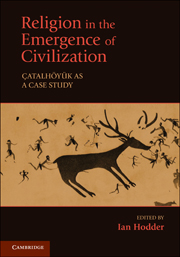Book contents
- Frontmatter
- Contents
- List of Figures and Tables
- Contributors
- 1 Probing religion at Çatalhöyük
- 2 The symbolism of Çatalhöyük in its regional context
- 3 Spiritual entanglement
- 4 Coding the nonvisible
- 5 Modes of religiosity at Çatalhöyük
- 6 Is there religion at Çatalhöyük…or are there just houses?
- 7 History houses
- 8 Marked, absent, habitual
- 9 Temporalities of “religion” at Çatalhöyük
- 10 The Neolithic cosmos of Çatalhöyük
- 11 Magical deposits at Çatalhöyük
- 12 Conclusions and evaluation
- Index
- References
12 - Conclusions and evaluation
Published online by Cambridge University Press: 05 June 2012
- Frontmatter
- Contents
- List of Figures and Tables
- Contributors
- 1 Probing religion at Çatalhöyük
- 2 The symbolism of Çatalhöyük in its regional context
- 3 Spiritual entanglement
- 4 Coding the nonvisible
- 5 Modes of religiosity at Çatalhöyük
- 6 Is there religion at Çatalhöyük…or are there just houses?
- 7 History houses
- 8 Marked, absent, habitual
- 9 Temporalities of “religion” at Çatalhöyük
- 10 The Neolithic cosmos of Çatalhöyük
- 11 Magical deposits at Çatalhöyük
- 12 Conclusions and evaluation
- Index
- References
Summary
What has been achieved by this experiment in interdisciplinary dialogue on an archaeological site? Archaeologists are so often forced to work in relative isolation as they excavate and analyze, being able to engage in wider debate only in summary conference papers, workshops and the literature. The Templeton project has now been extended for a further three years, with a larger group of scholars and with new forms of more intense collaboration and investigation. But we can for the moment take stock and ask whether the initial phase, reported on in this volume, of sustained interaction by a group of scholars with a set of archaeological data produced any added value for archaeology. And have the different disciplines themselves gained anything from their brush with the archaeological process?
In attempting to provide a summary and evaluation of the main conclusions and results I will organize my comments initially in relation to the four questions asked by the project. I will refer to the project participants who produced chapters for this volume, but also to others who contributed to the project listed in Chapter 1 but who did not write chapters.
- Type
- Chapter
- Information
- Religion in the Emergence of CivilizationÇatalhöyük as a Case Study, pp. 332 - 356Publisher: Cambridge University PressPrint publication year: 2010
References
- 3
- Cited by



